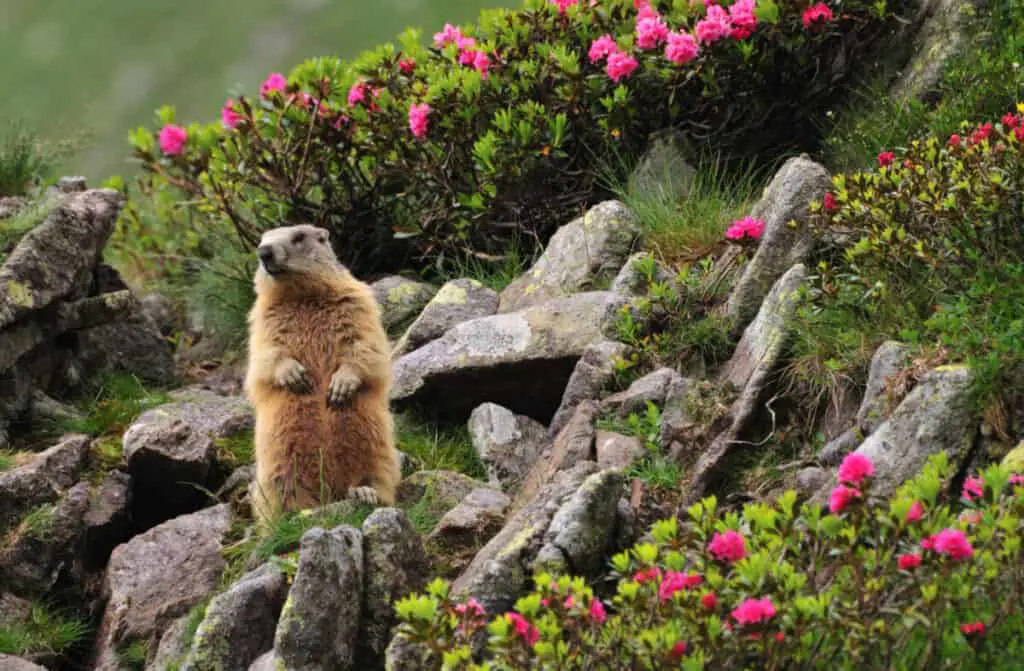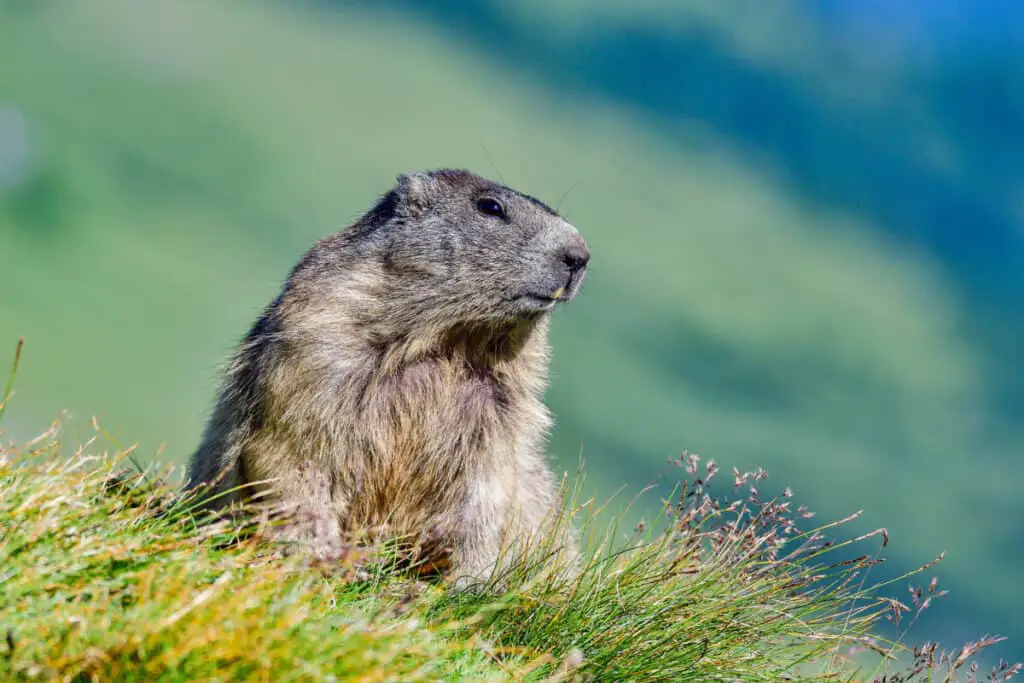Marmots are a group of large, ground-dwelling rodents that belong to the family Sciuridae. These animals are commonly found in mountainous regions across North America, Europe and Asia. There are 15 known species of marmots, each with their unique adaptations to different environmental conditions.
The physical appearance of marmots varies depending on the species, but they generally have stout bodies, short legs and long bushy tails. They range in size from small alpine marmots weighing around 1 kg to larger hoary marmots weighing up to 10 kg.
Marmots play an essential ecological role as herbivores and prey for predators such as eagles, wolves and bears. Additionally, these animals hibernate during winter months, which helps them conserve energy when food sources become scarce.
Despite their importance in ecosystems, several species of marmot have suffered population declines due to habitat loss and hunting pressures. This article will provide an overview of the biology and ecology of this fascinating group of mammals while highlighting some conservation efforts aimed at protecting them.

The Family Sciuridae
The family Sciuridae is a diverse group of rodents that includes squirrels, chipmunks, and marmots.
Marmots are large ground-dwelling squirrels that belong to the genus Marmota. They are found in various habitats throughout North America, Europe, and Asia.
Marmots have a herbivorous diet consisting mainly of grasses, herbs, and other vegetation.
During the summer months, they spend most of their time foraging for food to build up fat reserves for hibernation.
In winter, they enter into a state of torpor where their metabolism slows down and they survive on stored body fat.
Additionally, marmots exhibit social behavior such as living in colonies with complex social structures and vocalizing through whistles to communicate with each other.
Certainly! Here’s a table showcasing different species of marmots, their scientific names, and their geographic distributions:
| Marmot Species | Scientific Name | Distribution |
|---|---|---|
| Alpine Marmot | Marmota marmota | Alpine regions of central and southern Europe |
| Hoary Marmot | Marmota caligata | Northwestern North America |
| Yellow-bellied Marmot | Marmota flaviventris | Western North America |
| Olympic Marmot | Marmota olympus | Olympic Mountains of Washington, United States |
| Vancouver Island Marmot | Marmota vancouverensis | Vancouver Island, British Columbia, Canada |
| Long-tailed Marmot | Marmota caudata | Eastern Europe, Russia, and Central Asia |
| Himalayan Marmot | Marmota himalayana | Himalayan region of Asia |
| Black-capped Marmot | Marmota camtschatica | Eastern Siberia, Russian Far East, and Northeast China |
| Bobak Marmot | Marmota bobak | Eastern Europe and Central Asia |
| Menzbier’s Marmot | Marmota menzbieri | Central Asia |
| Tarbagan Marmot | Marmota sibirica | Mongolia and parts of China and Russia |
| Alpine Steppe Marmot | Marmota kastschenkoi | Central Asia and western Mongolia |
| Alai Marmot | Marmota alaica | Central Asia |
| Forest-steppe Marmot | Marmota kastschenkoi | Central Asia |
Please note that this table includes some of the commonly recognized species of marmots, but there may be additional subspecies or regional variations within each species.
Physical Characteristics Of Marmots
The Family Sciuridae is a diverse group of rodents that includes tree squirrels, ground squirrels, and chipmunks. Remarkably, the marmot belongs to this family as well.
Marmots are fascinating creatures with unique characteristics that distinguish them from other members of their family. Interestingly, there are 15 different species of marmots in the world today.
Marmots have specific habitat preferences that differ depending on the species. Most species prefer high altitude areas such as mountain meadows or rocky slopes, while others can be found in more arid regions such as deserts or steppes. They typically live in burrows which they dig themselves and use for hibernation during winter months.
One particular oddity about these animals is their social behavior; most marmot species are highly sociable and live in groups consisting of several individuals. Within each group, there is usually one dominant male who mates with all the females in his territory. The remaining males will often leave to establish territories elsewhere once they reach sexual maturity at around two years old.
Despite being social animals, some marmot species exhibit territorial behavior towards outsiders and may become aggressive if threatened by intruders.
Ecological Roles Of Marmots
Marmots play an important ecological role in their habitat, particularly with regards to burrowing. These animals are known for creating extensive underground tunnels and chambers, which can have a significant impact on the soil structure and nutrient cycling of their environment.
The mounds of earth that they excavate while digging these burrows also provide valuable resources for other organisms such as insects and plants.
In addition to their burrowing activities, marmots also have unique dietary habits that contribute to the ecosystem around them. They are primarily herbivorous, feeding on grasses, herbs, and flowers during the summer months when vegetation is abundant.
As winter approaches and food becomes scarce, they rely more heavily on stored fat reserves and may even eat bark or twigs from nearby trees.
By consuming plant material at different times throughout the year, marmots help to regulate plant populations and promote biodiversity within their habitat.
Hibernation And Adaptations For Survival
As winter approaches, the marmot prepares for a long slumber. Similar to a bear in hibernation, the marmot enters a state of torpor where its body temperature lowers and metabolism slows down significantly. However, unlike true hibernation, the marmot periodically wakes up from its deep sleep to warm itself up before going back into torpor. This adaptation allows the animal to conserve energy while still being able to respond quickly if any danger arises.
During this winter sleep pattern, the marmot’s heart rate can drop from around 135 beats per minute during active periods to as low as 30 beats per minute during torpor. The animal also decreases its breathing rate and may not require food or water for several months.
These adaptations are crucial for survival in harsh alpine environments where food is scarce and temperatures can plummet below zero degrees Celsius. Overall, understanding these strategies used by animals like the marmot sheds light on how organisms are able to adapt to extreme conditions and provides insight into potential solutions for human challenges such as climate change.
Threats To Marmot Populations
Marmots are facing a number of threats that put their survival at risk. One major threat is climate change, which affects the availability and quality of vegetation needed for their food supply. As temperatures continue to rise, it becomes increasingly difficult for marmots to find suitable habitats where they can thrive. Additionally, changes in precipitation patterns may lead to drought conditions or floods, both of which can further impact their habitat.
Another significant threat faced by marmot populations is habitat loss due to human activities such as mining and logging, which destroy or fragment their natural habitats. This not only reduces the available area for marmots but also creates barriers that prevent them from interacting with other members of their species. Habitat fragmentation leads to decreased genetic diversity within populations making them more vulnerable to diseases and environmental stressors.
The dwindling population sizes: A decrease in the numbers of these adorable creatures could evoke sympathy among people who value wildlife conservation.
Loss of cultural significance: Marmots have been valued as symbols for various cultures around the world; thus, losing them would be equivalent to losing an important aspect of our heritage.
Ecological imbalance: Marmots play vital roles in maintaining ecosystems by regulating plant growth through herbivory. Their absence would cause ecological imbalances leading to unpredictable consequences on many levels.
The two main threats posed towards marmot populations are climate change and habitat loss resulting from anthropogenic activities such as logging and mining.
These factors pose a severe risk towards marmot survival putting them under immense pressure as they struggle against harsh environmental conditions while simultaneously trying to maintain viable populations amidst rapid land-use changes. However, with proper measures taken into account, there is still hope that we can preserve this charismatic animal’s future existence in our planet’s biodiversity hotspots before time runs out.
Conservation Efforts For Marmots
The threats faced by marmot populations have highlighted the need for increased conservation efforts. Fortunately, many organizations and partnerships have stepped up to address these challenges in a collaborative manner.
In particular, community involvement has been key in developing effective conservation strategies. One successful example of community involvement is the Marmot Recovery Foundation (MRF), which works with local governments, First Nations communities, and researchers to protect endangered marmot species. The MRF engages volunteers from various backgrounds to assist with monitoring, habitat restoration, and public outreach initiatives. This collective effort has resulted in significant improvements in marmot population numbers and range expansion.
By involving local communities and building partnerships across sectors, conservation efforts can be more sustainable and impactful over the long term. As such, it is crucial that continued collaboration between stakeholders remains a priority moving forward.
With ongoing support from government agencies, academic institutions, non-profit organizations, and concerned citizens alike, there is reason for optimism regarding the future of marmots and their habitats. Through collective action, we can help safeguard these vital components of our natural world for generations to come.

Conclusion
The Family Sciuridae encompasses a variety of species, including the marmot. Marmots are ground-dwelling squirrels that typically live in mountainous areas.
They have thick fur and large, sturdy bodies adapted for life in cold environments. Marmots play important ecological roles as herbivores and prey for predators such as eagles and wolves.
During winter months, marmots enter hibernation to conserve energy when food is scarce. To survive this period, they undergo physiological changes such as lowered body temperature and heart rate.
Despite their adaptations, marmot populations face threats from habitat loss due to human activity and climate change.
Conservation efforts aim to protect these animals by preserving their habitats and monitoring population levels.
The survival of the marmot depends on our collective actions to mitigate environmental damage and preserve natural ecosystems.
As the saying goes, ‘We’re all in this together,’ and it’s up to us to ensure that future generations can witness these fascinating creatures in their natural habitats.

